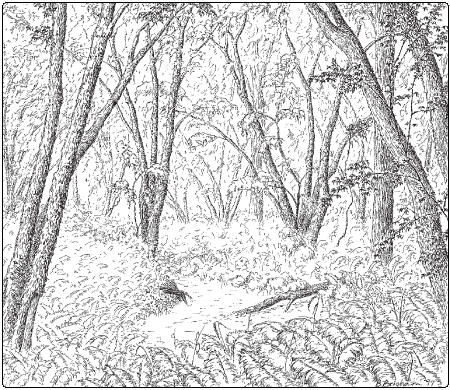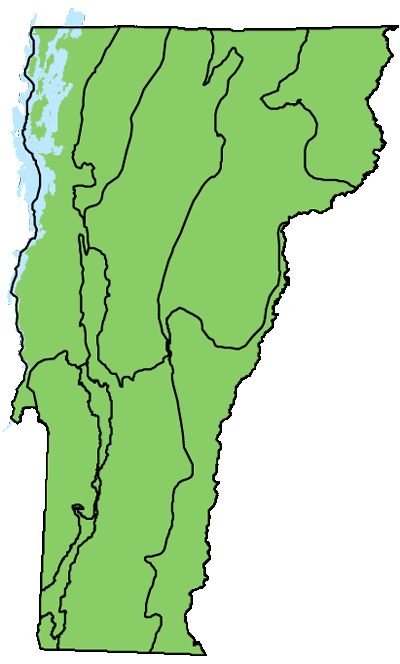Ecology and Physical Setting 
This floodplain forest is found on the low to moderate gradient portions of most of Vermont’s major rivers. These forests receive annual overbank flooding, but water tables may be well below the ground surface for most of the growing season. Levees and old channel meander scars are common micro-topographic features, reflecting the very dynamic nature of rivers in their floodplains. The alluvial soils are primarily sandy loams that are well to moderately well drained, and are without mottles in the upper portion. Due to annual soil deposition, there is no surface organic layer, although there may be thin buried lenses of decomposing leaves mixed with the alluvial soil. This floodplain forest type is almost always considered a wetland.
Vegetation
Entering a mature Silver Maple-Ostrich Fern Floodplain Forest can be awe-inspiring. Towering silver maples with pillar-like trunks and arching crowns up to 100 feet high create the impression of a cathedral interior. The near lack of shrubs adds an open, airy quality, but this cathedral is full of life. The rich, alluvial soils produce a luxuriant growth of ostrich fern and other herbaceous species that may reach shoulder or head height.
 Although silver maple dominates the canopy of these forests, cottonwood may be an important component at some sites. Large cottonwood trees may reach heights of 100 feet and have diameters at breast height of five feet or more. The fact that these immense trees are typically less than 90 years old indicates the quality of growing conditions in floodplain forests. Other tree species may include boxelder, hackberry, slippery elm, and American elm. This last species dominated many floodplains prior to the arrival of Dutch elm disease in the 1920s, and efforts to restore disease-resistant elms may bring this species back to prominence. Silver maple and boxelder seedlings and saplings are common where there are canopy openings. Shrubs are often sparse or lacking, but large riverbank grape vines frequently reach into the lower canopy. Ostrich fern forms a nearly complete ground cover in many of these forests, and wood nettle may be abundant in patches. Although seldom abundant, Wiegand’s wild rye, Canada brome, and wild cucumber are highly characteristic of this floodplain forest type.
Although silver maple dominates the canopy of these forests, cottonwood may be an important component at some sites. Large cottonwood trees may reach heights of 100 feet and have diameters at breast height of five feet or more. The fact that these immense trees are typically less than 90 years old indicates the quality of growing conditions in floodplain forests. Other tree species may include boxelder, hackberry, slippery elm, and American elm. This last species dominated many floodplains prior to the arrival of Dutch elm disease in the 1920s, and efforts to restore disease-resistant elms may bring this species back to prominence. Silver maple and boxelder seedlings and saplings are common where there are canopy openings. Shrubs are often sparse or lacking, but large riverbank grape vines frequently reach into the lower canopy. Ostrich fern forms a nearly complete ground cover in many of these forests, and wood nettle may be abundant in patches. Although seldom abundant, Wiegand’s wild rye, Canada brome, and wild cucumber are highly characteristic of this floodplain forest type.
Wildlife Habitat
Silver Maple-Ostrich Fern Floodplain Forest, Vermont’s most widespread floodplain forest, provides travel corridors for many mammals. Mink, otter, and beaver are all closely tied to rivers and streams and are common in adjacent floodplain forests. The tall silver maple canopies provide breeding habitat for migratory birds, including veery, warbling vireo, yellow-throated vireo, yellow warbler, and northern oriole. The uncommon blue-gray gnatcatcher and the rare cerulean warbler may both nest in these forests. The cerulean warbler is strongly associated with tall trees in mature floodplain forests. Large, old trees and dead standing snags provide nesting cavities near water for wood duck, hooded merganser, and common merganser.
Several invertebrates inhabit these floodplain forests. The twelve-spotted tiger beetle occurs on sandy and silty shorelines and into the riverside shade of floodplain forests. The larvae of the rare ostrich fern borer moth feed on the lower stems of ostrich fern. The larvae of two butterflies, tawny emperor and hackberry emperor, feed on the leaves of hackberry, a tree mostly restricted to floodplain forests and wooded talus in Vermont.
Related Communities
- Silver Maple-Sensitive Fern Floodplain Forest is distinguished by the abundance of sensitive fern, false nettle, and green ash; by the longer duration of annual flooding; and by the finer-textured soils.
- Sugar Maple Floodplain Forest occurs adjacent to higher gradient portions of rivers, and may occur on higher floodplain terraces. Many species common to upland hardwood forests and rich woods are present and the soils are better drained than in other floodplain forest types.
- Boreal Floodplain Forest occurs along rivers in Vermont’s coldest regions. The canopy is distinguished by white spruce, balsam fir, black ash, balsam poplar, and black cherry. Silver maple may be present but is not abundant.
Conservation Status and Management Considerations
There are very few undisturbed examples of this or other riverine floodplain forest types in Vermont, as most have long since been converted to agricultural uses. Non-native invasive plants are a particular threat to this community. The annual deposits of rich, alluvial soils provide an ideal substrate for many invasive species, enabling them to become established, to thrive, and often to exclude native species. Conservation and restoration of floodplain forests are critical for biodiversity protection, wildlife habitat and travel corridors, water quality improvement, and the natural functioning of river systems.
Distribution/Abundance
Silver Maple-Ostrich Fern Floodplain Forests occur throughout New England, New York, Pennsylvania, Maryland, Québec, and Ontario, with similar forests also present in the Midwest.
Characteristic Plants
Trees
Abundant Species
Silver maple – Acer saccharinum
Occasional to Locally Abundant Species
Cottonwood – Populus deltoides
American elm – Ulmus americana
Slippery elm – Ulmus rubra
Hackberry – Celtis occidentalis
Boxelder – Acer negundo
Black willow – Salix nigra
Butternut – Juglans cinerea
Sycamore – Platanus occidentalis
Shrubs and Vines
Occasional to Locally Abundant Species
Riverbank grape – Vitis riparia
Virginia creeper – Parthenocissus quinquefolia
Nannyberry – Viburnum lentago
Chokecherry – Prunus virginiana
Herbs

burial by annual alluvial deposits. Its fiddleheads
are a delectable spring treat.
Abundant Species
Ostrich fern – Matteuccia struthiopteris
Wood nettle – Laportea canadensis
Occasional to Locally Abundant Species
Spotted touch-me-not – Impatiens capensis
Jack-in-the-pulpit – Arisaema triphyllum
Groundnut – Apios americana
Sensitive fern – Onoclea sensibilis
Tall meadow rue – Thalictrum pubescens
Wild cucumber – Echinocystis lobata
Canada brome – Bromus latiglumis
Large enchanter’s nightshade – Circaea canadensis
Virginia wild rye – Elymus virginicus
Stout woodreed – Cinna arundinacea
Non-native Invasive Plants
Japanese knotweed – Fallopia japonica
Goutweed – Aegopodium podagraria
Dame’s rocket – Hesperis matronalis
Garlic mustard – Alliaria petiolata
Moneywort – Lysimachia nummularia
Common buckthorn – Rhamnus cathartica
Morrow’s honeysuckle – Lonicera morrowii
Tatarian honeysuckle – Lonicera tatarica
European spindle-tree – Euonymus europaeus
Rare and Uncommon Plants
Wiegand’s wild rye – Elymus wiegandii
Hairy wild rye – Elymus villosus
Meadow horsetail – Equisetum pratense
Great Solomon’s seal – Polygonatum biflorum
Common hedge nettle – Stachys hispida
Associated Animals
Spring peeper – Pseudacris crucifer
River otter – Lontra canadensis
Mink – Neovison vison
American beaver – Castor canadensis
Great blue heron – Ardea herodias
Veery – Catharus fuscescens
Eastern wood pewee – Contopus virens
Great crested flycatcher – Myiarchus crinitus
Warbling vireo – Vireo gilvus
American redstart – Setophaga ruticilla
Yellow warbler – Setophaga petechia
Yellow-throated vireo – Vireo flavifrons
Baltimore oriole – Icterus galbula
Wood duck – Aix sponsa
Hooded merganser – Lophodytes cucullatus
Common merganser – Mergus merganser
Slender spreadwing – Lestes rectangularis
Twelve-spotted tiger beetle – Cicindela duodecimguttata
Rare and Uncommon Animals
Fowler’s toad – Anaxyrus fowleri
Wood turtle – Glyptemys insculpta
Indiana bat – Myotis sodalis
Red-shouldered hawk – Buteo lineatus
Cerulean warbler – Setophaga cerulea
Blue-gray gnatcatcher – Polioptila caerulea
Osprey – Pandion haliaetus
Hackberry emperor – Asterocampa celtis
Tawny emperor – Asterocampa clyton
Ostrich fern borer moth – unnamed Papaipema species
Places to Visit
South Bay Wildlife Management Area, Coventry, Vermont Fish and Wildlife Department (VFWD)
Lamoille River Delta, Milton and Colchester, Sandbar Wildlife Management Area, VFWD
Halfmoon Cove Wildlife Management Area, Colchester, VFWD
Derway Island, Burlington, Winooski Valley Park District
Richmond Rivershore Preserve, Richmond Land Trust and The Nature Conservancy (TNC)
Otter Creek (Cornwall Swamp), Cornwall and Salisbury, VFWD and TNC
White River Wildlife Management Area, Sharon, VFWD
Hartland Rivershore Natural Area, Hartland, TNC
